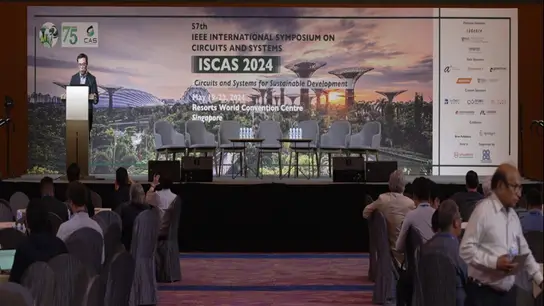Moore with Less: Ultra-Low Energy Neuromorphic Circuits and Systems for Large-Scale Distributed AI Slides
Gert Cauwenberghs
-
Members: Free
IEEE Members: Free
Non-members: FreePages/Slides: 43
20 May 2024
Abstract: The rapidly increasing volume of computational power needed to train and run ever more sophisticated models in artificial intelligence, driven by an insatiable appetite for access to information about anything anywhere and anytime, is consuming massive amounts of energy depleting the earth's resources and aggravating climate change at an alarming rate. Inspired by the efficiency, efficacy, and resilience of natural intelligence in biological information processing systems, a principled approach to neuromorphic engineering design offers sustainable alternatives for ultra-low energy cognitive computing in massively parallel distributed architecture, permitting continued advances in Moore's law scaling of semiconductor technology as shrinking device dimensions approach physical limits where individual operational reliability is no longer warranted. System-level accuracy and efficiency emerge from the robust adaptive collective dynamics of large assemblies of imprecise individual nanoscale elements which, like neurons and synapses in the central nervous system, operate near fundamental thermodynamic limits of noise-energy efficiency. Examples include a fully silicon integrated memristive computein- memory chip to combine at once superior energy efficiency and near-full digital equivalent accuracy supporting a versatile range of model architectures for reconfigurable and heterogeneous AI on the edge, and a chargedomain compute-in-memory array with resonant adiabatic energy recovery consuming less than one femtojoule of energy per multiply-accumulate synaptic operation approaching nominal efficiency of synaptic transmission in the mammalian brain.
Biography: Gert Cauwenberghs is Professor of Bioengineering and Co-Director of the Institute for Neural Computation at UC San Diego, La Jolla CA. His research focuses on micropower integrated biomedical circuits, neuron-silicon and brain-machine interfaces, neuromorphic engineering, and adaptive intelligent systems. He is a Fellow of IEEE and the American Institute for Medical and Biological Engineering (AIMBE). He served IEEE in a variety of roles including as Distinguished Lecturer of the IEEE Circuits and Systems Society, as VP of Technical Activities on the Executive Committee of the IEEE Engineering in Medicine and Biology Society, on the Steering Committee of IEEE Brain, and as Editor-in-Chief of the IEEE Transactions on Biomedical Circuits and Systems.


